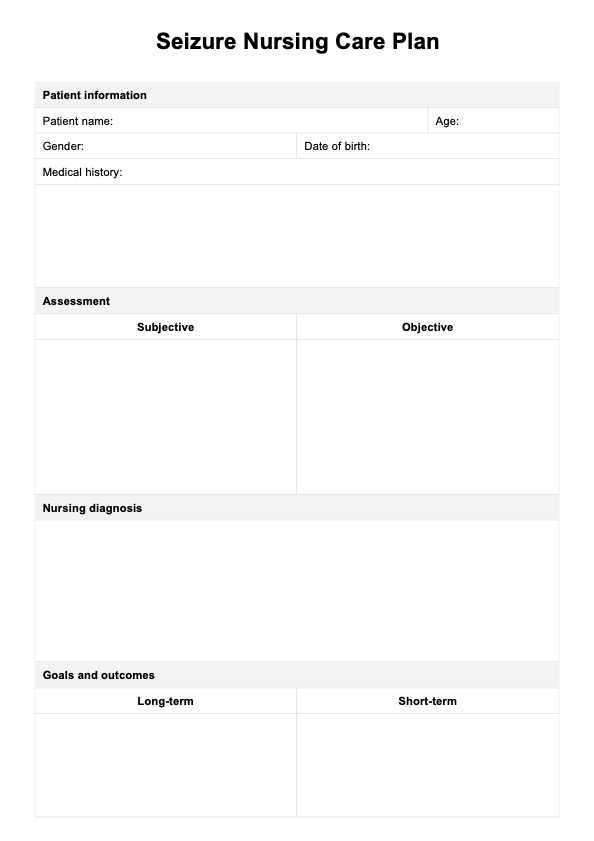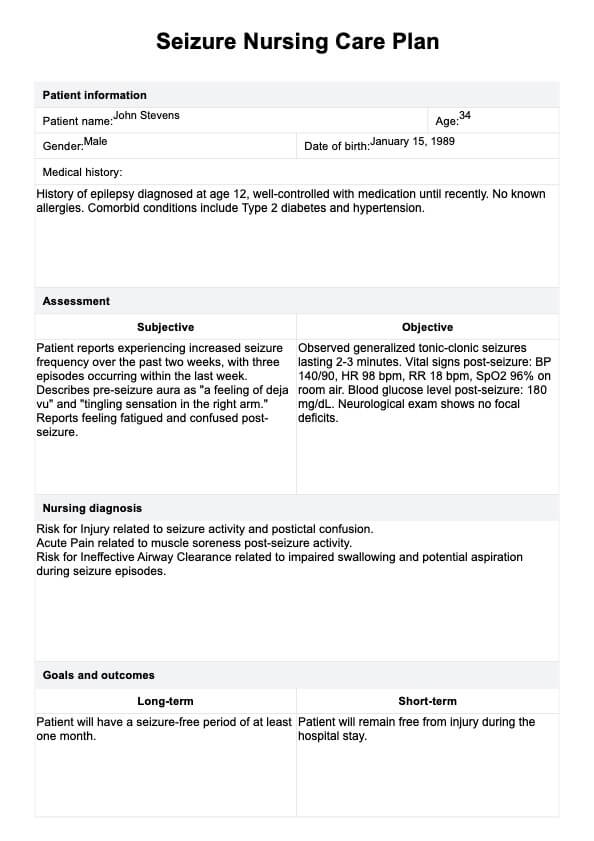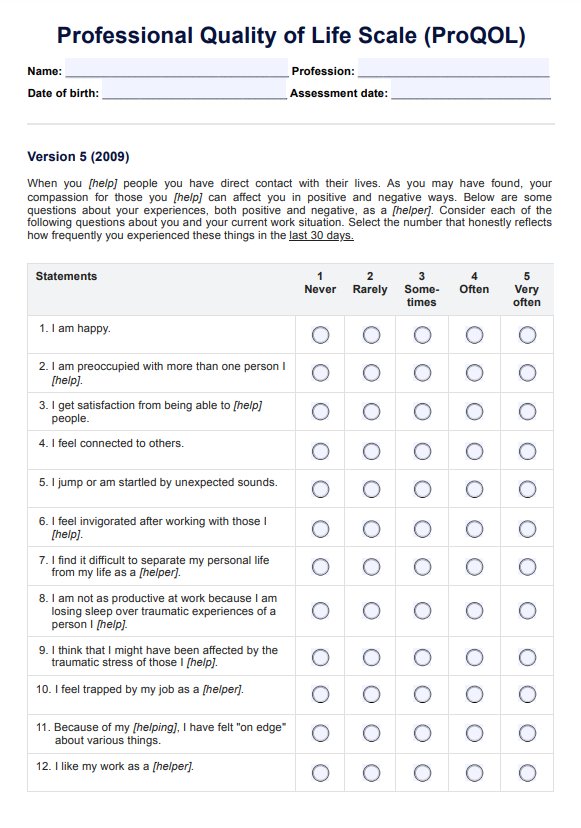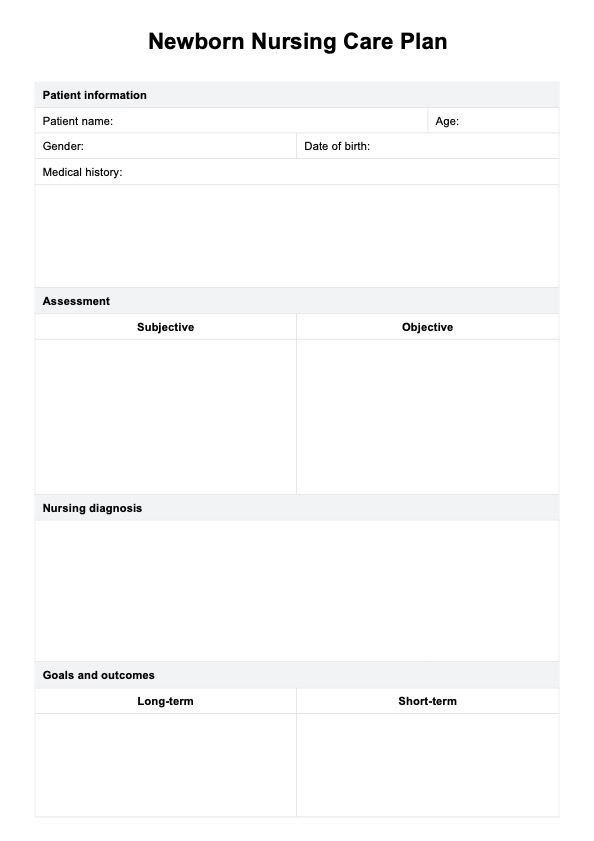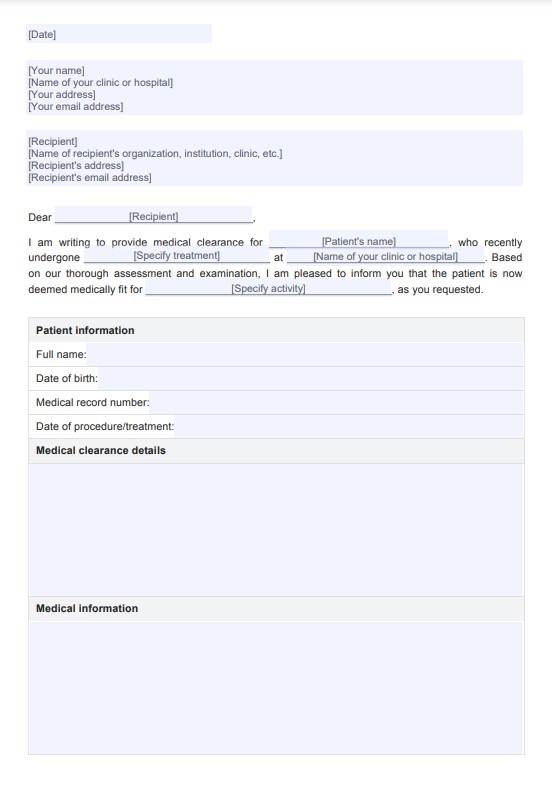Seizures Nursing Care Plan
Optimize your patient care with our Seizures Nursing Care Plan template. Streamline documentation, enhance safety, and improve outcomes efficiently.


What is a Seizures Nursing Care Plan?
A Seizures Nursing Care Plan is a comprehensive tool designed to help you manage and document the care of patients experiencing seizures, which are episodes of abnormal electrical activity in the brain. This plan provides a structured approach to patient assessment, identifying key components such as seizure history, neurological examinations, and vital signs. By outlining specific nursing interventions and setting clear goals, the seizure disorder care plan ensures you can provide targeted and effective care tailored to each patient’s needs.
Using a Seizures Nursing Care Plan is crucial for maintaining consistency and safety in patient care. It helps you proactively address potential complications, such as injury during a seizure or postictal confusion, and provides a clear framework for monitoring patient progress. The plan also facilitates communication among the healthcare team, ensuring that everyone involved in the patient’s care is aligned and informed, ultimately leading to improved patient outcomes and a more efficient care process.
Seizures Nursing Care Plan Template
Seizures Nursing Care Plan Example
How to use our Seizures Nursing Care Plan template
Our Seizures Nursing Care Plan template is designed to simplify managing and documenting care for patients with seizure disorders. Here's how you can make the most of our template:
Step 1: Download the template
To make the most of this fully customizable seizure care plan template within the Carepatron app, just click the "Use Template" button. Alternatively, you can click the "Download" button to get a PDF version for your records.
Step 2: Fill in patient information
Add the patient's name, age, gender, and other relevant demographic information to the designated fields in the template. This ensures that you have a clear record of which patient this care plan is for.
Step 3: Perform an assessment
Assessing your patient's condition is crucial in developing an effective nursing care plan. Use our template's "Assessment" section to document vital signs, physical examination findings, risk factors, seizure frequency, and any additional data gathered from the patient or their medical records.
Step 4: Identify nursing diagnoses, goals and outcomes
Use the designated fields to identify any nursing diagnoses, goals and outcomes for the patient. These should be supported by evidence from your assessment and any additional information gathered.
Step 5: Plan interventions
Based on the identified nursing diagnoses, set out a plan of interventions to address each diagnosis, which may include seizure control measures, documenting prescribed antiepileptic medications, and more.
Step 6: Add rationale and evaluation
For each intervention, provide a rationale for why it was chosen and how it will address the nursing diagnosis. After implementing the interventions, use the designated fields to document their effectiveness in achieving the desired outcomes.
Step 7: Periodically review and update
Seizure disorders can be unpredictable and may require frequent adjustments to the nursing care plan. It is important to periodically review and update the plan as needed. Use our template's "Additional notes" section to document any changes made and the reasons for them.
Key nursing interventions for seizure management
Implementing specific nursing interventions tailored to each patient’s needs is important when filling out the Seizures Nursing Care Plan template. These interventions are vital for managing epileptic seizures effectively and ensuring patient safety and comfort throughout their care. Below are key strategies that can provide comprehensive support to seizure patients experiencing episodes:
Seizure precautions
Implementing seizure precautions is essential to prevent injury during and after seizure episodes. For focal seizures, it is important to understand warning signs and take precautions to minimize risks, such as avoiding injuries during episodes. For generalized seizures, including tonic-clonic and absence seizures, precautions should focus on preventing loss of consciousness and convulsions by ensuring a safe environment and having nearby suction equipment to clear the airway if necessary.
These precautions help protect the patient from physical harm and reduce the risk of complications, such as aspiration, during a seizure.
During seizure care
During an active seizure, your primary focus should be maintaining the patient's safety and airway patency. Position the patient on their side to prevent aspiration and keep an open airway. Do not restrain the patient or attempt to place anything in their mouth, as this could cause injury. Monitor the duration and characteristics of the seizure, including the patient's level of consciousness and motor activity, and document these observations in the care plan.
If the seizure lasts longer than five minutes or there are multiple seizures without recovery between them, be prepared to administer emergency medications as prescribed and follow emergency protocols.
Post-seizure care
Once the seizure has subsided, focus on the patient’s recovery. Understanding various seizure types is crucial for developing an effective seizure nursing diagnosis care plan, which is essential for identifying potential triggers and preventing future episodes. Assess their level of consciousness and perform a quick neurological check to determine any postictal deficits, such as confusion or weakness. Provide a calm, quiet environment to help the patient recover and offer reassurance and support.
Document any postictal symptoms and the patient’s response to interventions, as this information is crucial for evaluating their recovery and planning future care. If necessary, prepare for further evaluation or adjust the patient’s care plan based on their condition.
Benefits of using our template
Utilizing our Seizures Nursing Care Plan template offers several significant advantages for you as a healthcare professional. This template is designed to streamline your workflow, enhance patient care, and improve overall communication within your team. Here are three key benefits you can expect:
Enhances accuracy and consistency
Our template ensures you capture all essential details about your patient’s condition, interventions, and outcomes in a standardized format. This consistency helps reduce errors and ensures that every patient's care is thoroughly documented. By having a clear, structured approach, you can maintain high standards of care and ensure that critical information is easily accessible to all team members.
Saves time and improves efficiency
The template provides a ready-made structure for documenting care, allowing you to focus more on patient interactions than administrative tasks. This saves you valuable time during busy shifts and helps you manage your workload more effectively. With everything laid out clearly, you can quickly input data, update care plans, and review patient progress without missing any crucial steps.
Commonly asked questions
A comprehensive plan of care for seizures should include a detailed medical history, a record of the types and frequency of seizures experienced, triggers, and the specific medications prescribed, along with their dosages. It is also crucial to outline emergency procedures, such as how to respond during a seizure and when to seek medical help.
Writing an epilepsy care plan involves gathering essential information about the individual's condition, including their seizure history, diagnosis, and treatment options. The plan should clearly outline the roles and responsibilities of caregivers and specific interventions for managing seizures.
Creating a seizure plan requires a systematic approach that begins with identifying the person's unique seizure triggers and patterns. The plan should outline preemptive measures to minimize risks, such as avoiding certain activities during high-risk times. It should also detail the steps to take during a seizure, including how to keep the individual safe and when to call for emergency help.


